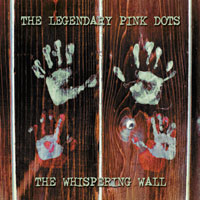 |
THE
LEGENDARY PINK DOTS
THE WHISPERING
WALL
ALBUM
ROIR RELEASE:
APRIL 28, 2004 (NORTH AMERICA),
JUNE 11 (EUROPE) REVIEW: JULY
7, 2004
 |
New
turns are constantly added to the
labyrinth that is the discography
of The Legendary Pink Dots, in the
shape of new albums proper, CD-R:s,
live MP3:s, compilations and solo
albums. On the very same day as “The
Whispering Wall” another new
Legendary Pink Dots album, “Poppy
Variations”, and a new Edward
Ka-Spel solo album, “Pieces
of 8”, were released (both on
Beta-Lactam Ring Records). Add extensive
touring to this, and you’ve
got a band that’s confusingly
prolific.
Amazingly,
the creativity seems to remain boiling
within The Legendary Pink Dots’
collective body. We have sadly not
received promos of the other mentioned
new releases, but “The Whispering
Wall” is the band at their surrealist
best. The spacious electronic textures
combined with concrete samples and
Niels van Hoornblower’s saxophone
and clarinet make “The Whispering
Wall” almost three dimensional-sounding;
music as architecture.
Enter it and you’ll find yourself
in an uncanny forest that could have
been picked from a Max Ernst painting,
only to in the next breath be transported
to some underground carnival where
demented entertainers share the space
with jars of pickled punks stacked
on shelves made of contorted pig skeletons.
Turn around and you’re suddenly
in the grip of bizarre, brilliant
nursery rhyme “Peek-a-boo”,
which sounds as though it was recorded
for the amusement of the giant baby
in Miyazaki's “Spirited Away”,
and makes me dance around the room
like a loony.
If
at the first few listens the album
appears sketchy in places, be patient
and almost everything will fall into
place in due time. For instance, the
lyrics to “The Divide”,
a claustrophobic tale of a man shipwrecked
in his own hi tech apartment, looks
almost banal printed in the booklet,
but recorded they’re transformed
into a sonic nightmare of frightening
intensity, further proof of the Dots
alchemical grip on sound.
A word of warning, though. Once the
album’s finished playing you
may well find yourself at the bottom
of the rabbit hole with no way back.
KRISTOFFER
NOHEDEN
|
|